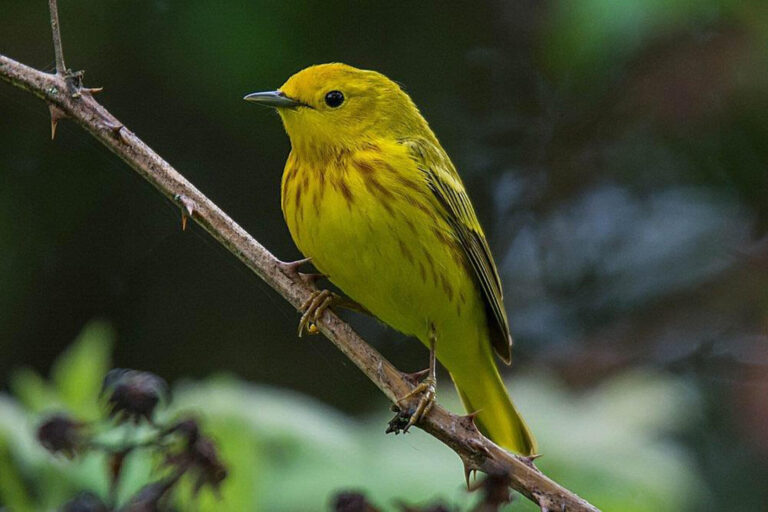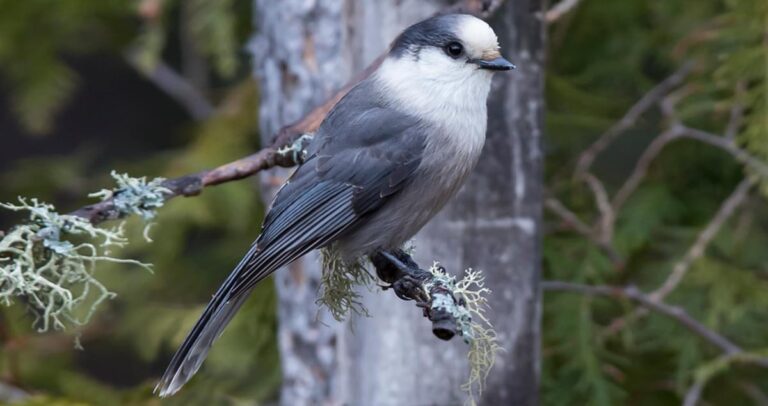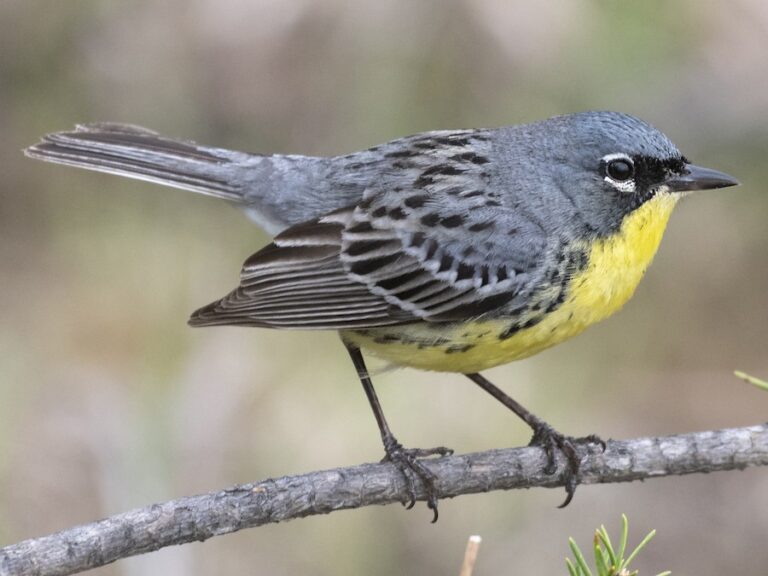20 Birds With Colorful Beaks Identification With Pictures
Birds are known for their vibrant plumage, but their beaks are just as fascinating, often serving as a colorful extension of their personalities. These beaks come in various shapes and hues, providing not only an aesthetic appeal but also critical functions for the birds’ survival, such as feeding, mating, and communication. Here are 20 remarkable bird species with colorful beaks that captivate the imagination.
1. Toucan (Ramphastos toco)
The toucan is arguably the most iconic bird with a colorful beak. With its massive, brightly colored bill, it stands out in the dense tropical forests of Central and South America. The toucan’s beak can be up to half the length of its body and comes in a range of vibrant colors, from yellows and oranges to reds and greens. Despite its size, the toucan’s bill is surprisingly light due to its honeycomb structure.

Beyond its striking appearance, the toucan uses its beak for a variety of purposes. It helps with feeding, allowing the bird to grab fruit and bring it back to its perch. The bill also plays a role in thermoregulation, as the bird can dissipate excess heat through it. During mating season, the toucan may also use its colorful bill to attract a mate, displaying it prominently as a sign of health and vitality.
Toucan Attributes:
- Length: 25-29 inches
- Weight: 1.5 to 2 pounds
- Beak Length: Up to 8 inches
- Habitat: Tropical rainforests
- Diet: Primarily fruit, insects, and small animals
- Conservation Status: Least concern
2. Scarlet Ibis (Eudocimus ruber)
The scarlet ibis is a bird that impresses with its rich red feathers and striking bill. Native to South America and the Caribbean, the scarlet ibis has a long, slender, and downward-curved beak, which is dark at the tip but gradually becomes a brighter orange as you move toward the base. This vivid coloration stands out against its bright red plumage, making it one of the most visually stunning birds.

The beak of the scarlet ibis is perfectly adapted for its feeding habits. It uses it to probe mud and shallow waters for small invertebrates and crustaceans. The bird’s feeding technique involves stirring the substrate with its beak and catching its prey. The bright coloration of the ibis’ beak also plays a role in its courtship rituals, as it signals the bird’s fitness to potential mates.
Scarlet Ibis Attributes:
- Length: 23-28 inches
- Weight: 1.6-2.5 pounds
- Beak Length: 6-8 inches
- Habitat: Coastal wetlands and mudflats
- Diet: Crustaceans, insects, and small fish
- Conservation Status: Near Threatened
3. Mandarin Duck (Aix galericulata)
Known for its stunning plumage, the mandarin duck is another bird that boasts a beautiful beak. Native to East Asia, the mandarin duck’s bill is a soft orange color with a distinct red band near the base. This striking beak contrasts beautifully with its vibrant feathers, which include hues of orange, blue, and green. The mandarin duck is often seen in ponds and lakes, where it is a favorite subject for birdwatchers.

The mandarin duck’s beak plays a critical role in its feeding behavior. It uses its bill to forage for food like aquatic plants, seeds, and small insects. The beak’s specialized shape also helps the bird filter out inedible material while feeding. In addition to its feeding function, the mandarin duck’s colorful bill plays a role in mate selection, with more vibrant bills often indicating better health and reproductive success.
Mandarin Duck Attributes:
- Length: 18-21 inches
- Weight: 1.5-2.5 pounds
- Beak Length: 1.5 inches
- Habitat: Freshwater lakes, rivers, and ponds
- Diet: Seeds, aquatic plants, and insects
- Conservation Status: Least concern
4. Hornbill (Bucerotidae family)
Hornbills are large, colorful birds found in Africa and Asia. Their most distinguishing feature is their large, curved beak, often adorned with a colorful casque (a helmet-like structure) on top. These birds are known for their bold and striking beaks, which come in shades of yellow, orange, red, and even blue. The hornbill’s beak is not just for show – it serves practical purposes for catching food and defending its territory.

The hornbill is an omnivorous bird, using its powerful beak to grab fruit, small animals, and insects. Its casque may help amplify its vocalizations or assist in mating displays. Male hornbills typically have larger and more colorful casques, which signify strength and genetic fitness, helping them attract mates during the breeding season.
Hornbill Attributes:
- Length: 25-55 inches
- Weight: 3.5-10 pounds
- Beak Length: 6-8 inches
- Habitat: Forests, savannas, and tropical woodlands
- Diet: Fruit, insects, and small vertebrates
- Conservation Status: Varies by species (some threatened)
5. Pelican (Pelecanidae family)
Pelicans are large water birds recognized for their distinctive long, colorful beaks. These birds are often associated with coastal regions, where they are frequently seen diving for fish. A pelican’s beak is long and slender, often with a bright orange, yellow, or red hue, depending on the species. The pelican’s pouch, which extends from its lower mandible, is another unique feature that complements its colorful beak.
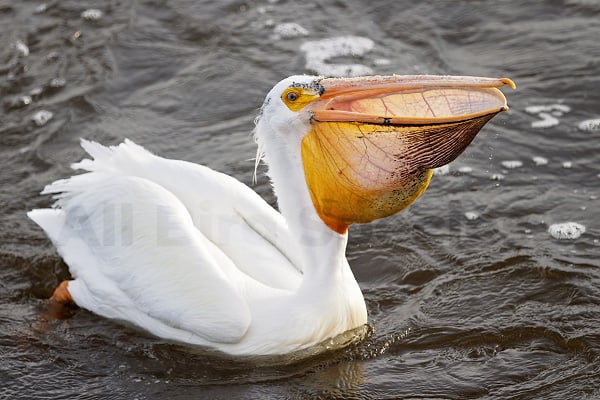
Pelicans use their beaks to scoop up fish while flying or swimming over the water. The large pouch helps them capture and hold their prey before swallowing it. Their vibrant beaks also play a role in social interactions and mating displays, with brighter colors typically indicating healthier, more dominant birds. Pelicans can be found in various habitats, from temperate coasts to tropical shores all over the world.
Pelican Attributes:
- Length: 39-70 inches
- Weight: 6-15 pounds
- Beak Length: 12-14 inches
- Habitat: Coastal waters, lakes, and rivers
- Diet: Fish and other aquatic creatures
- Conservation Status: Least concern
6. Roseate Spoonbill (Platalea ajaja)
The roseate spoonbill is a beautiful bird with a distinctive pink plumage and a unique, spoon-shaped beak. The beak of the spoonbill is a pale yellow at the base and gradually transitions to a vibrant red at the tip. This striking beak helps the bird feed in shallow waters, where it sweeps its bill from side to side in search of small fish and invertebrates.

The roseate spoonbill’s beak is perfectly suited to its feeding habits, allowing it to filter out food from the muddy waters in which it lives. During breeding season, the bird’s colorful bill plays an important role in courtship rituals, where males will often display their beaks and plumage to attract a mate. Their vibrant colors also help them stand out in the crowded wetlands where they live.
Roseate Spoonbill Attributes:
- Length: 28-34 inches
- Weight: 4-5 pounds
- Beak Length: 6-9 inches
- Habitat: Shallow coastal waters, wetlands
- Diet: Fish, invertebrates, and amphibians
- Conservation Status: Least concern
7. Kingfisher (Alcedinidae family)
Kingfishers are small to medium-sized birds known for their brilliant plumage and sharp, pointed bills. Their beaks come in a range of colors, including bright orange, red, and blue. Kingfishers are excellent hunters, often seen diving into water to catch small fish or insects. The bright colors of their beaks make them easy to spot as they fly swiftly over rivers and streams.
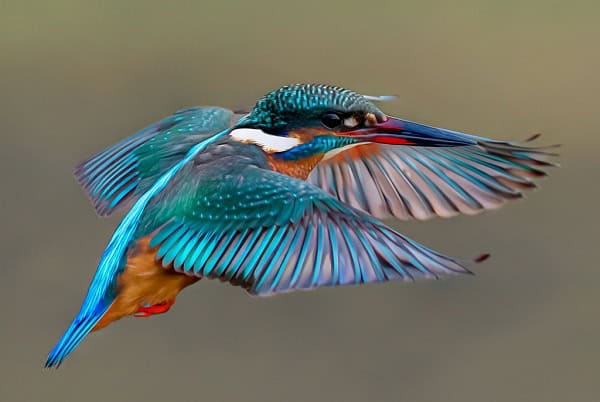
The kingfisher’s beak is well adapted to its feeding habits. It uses its sharp bill to snatch fish from the water with precision and speed. Kingfishers often nest in tunnels along riverbanks, where they raise their young away from predators. The colorful bills of male kingfishers may also be used in courtship displays to attract females.
Kingfisher Attributes:
- Length: 5-17 inches
- Weight: 2-5 ounces
- Beak Length: 1.5-3 inches
- Habitat: Freshwater rivers, lakes, and ponds
- Diet: Fish, insects, and small amphibians
- Conservation Status: Varies by species
8. Great Hornbill (Buceros bicornis)
The great hornbill is a large bird with an impressive, colorful bill that is a bright yellow and black color, complemented by its large casque. Native to the forests of Southeast Asia, the great hornbill is an omnivore, feeding on fruits, small mammals, and insects. The hornbill’s large, powerful bill is not only a tool for feeding but also an important element in its social interactions.

During the breeding season, the male great hornbill uses its bright bill to impress females. The casque on top of its bill may serve to amplify its calls or signal its dominance over other males. Hornbills like the great hornbill also play a vital role in maintaining the health of the forest ecosystem by dispersing seeds.
Great Hornbill Attributes:
- Length: 39-47 inches
- Weight: 4-6.5 pounds
- Beak Length: 7-9 inches
- Habitat: Tropical forests in Southeast Asia
- Diet: Fruits, small mammals, and insects
- Conservation Status: Vulnerable
9. Sun Conure (Aratinga solstitialis)
The sun conure is a small parrot with an exceptionally vibrant, colorful beak. This bird’s bill is a striking combination of orange, yellow, and black, which complements its bright, fiery plumage. Native to the northeastern parts of South America, the sun conure is often seen in large flocks, where its colorful appearance is a beacon in the wild. The conure’s bill is not only attractive but functional, helping it crack seeds and nuts, which make up a significant portion of its diet.

The sun conure is a highly social bird, often found in groups that engage in playful behavior. Its beak is also used for grooming, communication, and during mating rituals. The bird’s vivid, colorful beak may play a role in attracting mates, with brighter bills being a sign of good health and genetic fitness. Sun conures are also known for their ability to mimic sounds and their playful nature, making them popular pets.
Sun Conure Attributes:
- Length: 12-14 inches
- Weight: 4-5 ounces
- Beak Length: 1 inch
- Habitat: Tropical and subtropical forests in South America
- Diet: Seeds, fruits, and nuts
- Conservation Status: Endangered
10. Keel-billed Toucan (Ramphastos sulfuratus)
The keel-billed toucan, often called the “rainbow toucan,” is another bird famous for its colorful bill. Found in Central America, this bird is known for its large, vividly colored beak, which includes shades of green, yellow, orange, and red. The size of the bill can be up to a third of the bird’s body length. Despite its size, the beak is lightweight and helps the toucan reach fruits and insects that other birds cannot access. Its vibrant colors make it one of the most recognizable birds in the tropics.

The keel-billed toucan is a frugivore, feeding mostly on fruit, but it also consumes insects, small reptiles, and eggs. The bird’s colorful bill serves multiple purposes, such as helping it reach food on tall branches and providing a visual display for courtship. It is also believed that the bird uses its beak to regulate its body temperature by allowing heat to dissipate.
Keel-billed Toucan Attributes:
- Length: 18-22 inches
- Weight: 14-20 ounces
- Beak Length: 7-8 inches
- Habitat: Tropical forests of Central America
- Diet: Primarily fruit, but also insects and small animals
- Conservation Status: Least concern
11. Mandarin Pheasant (Chrysolophus amherstiae)
The mandarin pheasant is a stunning bird native to China, known for its iridescent plumage and its strikingly colorful bill. The bill of the mandarin pheasant is typically pale yellow to light green, providing a sharp contrast to the deep reds, greens, and blues of the bird’s feathers. While the bird’s feathers are the main attraction, its bill is equally unique, playing an essential role in its survival. The mandarin pheasant uses its bill to forage for seeds, grains, and insects, using its sharp beak to dig through the forest floor.

The mandarin pheasant is a ground-dwelling bird that enjoys dense, temperate forests, where it can find both food and shelter. It is a solitary bird, though it occasionally forms loose groups during the non-breeding season. The male mandarin pheasant displays its colorful beak during courtship to attract the attention of potential mates. The vibrant colors of its bill, along with its unique plumage, make it a beautiful and iconic species.
Mandarin Pheasant Attributes:
- Length: 26-31 inches
- Weight: 1.5-2.5 pounds
- Beak Length: 1.5 inches
- Habitat: Dense forests and woodlands in China
- Diet: Seeds, grains, and insects
- Conservation Status: Least concern
12. American Flamingo (Phoenicopterus ruber)
The American flamingo, with its long neck and graceful posture, is famous for its vibrant pink plumage and distinctive bill. The flamingo’s beak is bright orange with a black tip, which is slightly curved, allowing it to filter-feed on algae and small invertebrates in shallow water. The beak of the flamingo is designed to function like a strainer, enabling it to sift through mud and water to capture food.

The American flamingo’s feeding method involves submerging its head upside down in the water, using its uniquely shaped beak to filter out microscopic organisms. During mating season, flamingos gather in large groups, where their synchronized movements and the vivid colors of their beaks become part of their elaborate courtship rituals. Their long, colorful beaks are often used in displays to attract mates.
American Flamingo Attributes:
- Length: 45-50 inches
- Weight: 3.5-6.5 pounds
- Beak Length: 4-5 inches
- Habitat: Coastal wetlands, lagoons, and mudflats
- Diet: Algae, crustaceans, and small invertebrates
- Conservation Status: Least concern
13. Red-and-green Macaw (Ara chloropterus)
The red-and-green macaw is another parrot species known for its brilliant plumage and large, colorful bill. The beak of this macaw is predominantly black with a pale yellow-orange tone around the base, making it stand out against its vibrant red, yellow, and green feathers. This parrot is native to the rainforests of Central and South America, where it uses its beak to crack open nuts, seeds, and fruits.

Red-and-green macaws are highly social birds, often seen in pairs or groups. Their beaks are strong and durable, perfect for breaking into hard-shelled fruits or seeds. The macaw’s colorful bill also plays a role in its courtship, with brighter bills often a sign of good health. The macaw’s remarkable appearance and intelligence make it a beloved species in both the wild and in captivity.
Red-and-green Macaw Attributes:
- Length: 33-36 inches
- Weight: 2.5-3.5 pounds
- Beak Length: 2.5 inches
- Habitat: Rainforests in Central and South America
- Diet: Seeds, nuts, fruits, and flowers
- Conservation Status: Least concern
14. Yellow-billed Hornbill (Tockus flavirostris)
The yellow-billed hornbill is a small, striking bird found in sub-Saharan Africa. Its beak is a brilliant yellow with a black tip, and it is slightly curved, making it appear like a small version of the larger hornbills. This bird has a strong beak, which it uses to dig for insects, small reptiles, and fruit. The vivid yellow coloration of its bill is one of the bird’s most distinctive features.
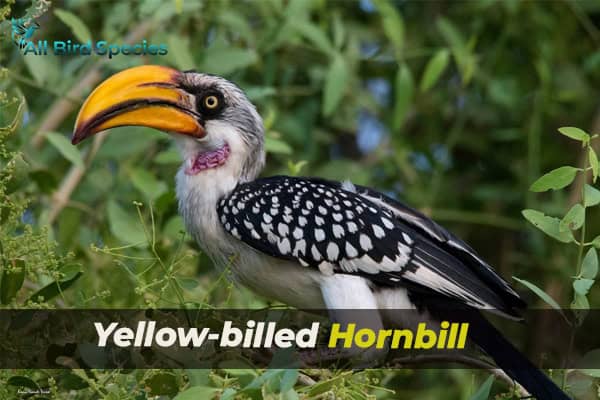
The yellow-billed hornbill is often found in savanna or forested habitats, where it can forage for food and nest in tree hollows. Its colorful bill is also used during courtship rituals, where it may display its bill to attract mates. The yellow-billed hornbill’s vocalizations are another form of communication, and its bill may amplify its calls during territorial disputes.
Yellow-billed Hornbill Attributes:
- Length: 18-24 inches
- Weight: 7-10 ounces
- Beak Length: 4-5 inches
- Habitat: Savannahs and woodlands in sub-Saharan Africa
- Diet: Insects, small reptiles, and fruit
- Conservation Status: Least concern
15. Pink-headed Duck (Rhodonessa caryophyllacea)
The pink-headed duck is a rare and enigmatic bird from South Asia, known for its unique, colorful bill. Its beak is pale blue with a pinkish tint around the base, giving it an almost translucent appearance. Unfortunately, this species is critically endangered and is rarely seen in the wild. The bird is believed to have once lived in the wetlands of India and Myanmar, where it fed on aquatic plants and small invertebrates.

The pink-headed duck’s bill was perfectly adapted to its feeding habits, allowing it to forage for soft vegetation and invertebrates in the marshes. Its rarity and limited sightings make it a subject of much intrigue among ornithologists, and conservation efforts are ongoing to protect this extraordinary bird.
Pink-headed Duck Attributes:
- Length: 20-25 inches
- Weight: 1-1.5 pounds
- Beak Length: 2-3 inches
- Habitat: Wetlands and marshes of South Asia
- Diet: Aquatic plants and invertebrates
- Conservation Status: Critically Endangered
16. Golden-crowned Kinglet (Regulus satrapa)
The golden-crowned kinglet, a tiny songbird found in North America, is known for its distinctive yellow and black crown. While this bird’s bill isn’t as long or brightly colored as some others on this list, it has a small, sharp, black beak that stands out against its bright yellow head. The beak is perfect for catching small insects, which make up a large part of its diet.
This kinglet’s beak is suited for foraging in the canopy of coniferous forests, where it hunts for insects and spiders. The golden-crowned kinglet is a very active bird, constantly flitting from branch to branch in search of food. Its small, sharp bill allows it to quickly snatch up insects while avoiding larger predators. The bird’s crown, which is bright yellow during the breeding season, also adds to its colorful appearance.
Golden-crowned Kinglet Attributes:
- Length: 3.5-4 inches
- Weight: 0.2-0.3 ounces
- Beak Length: 0.5 inches
- Habitat: Coniferous forests in North America
- Diet: Insects, spiders, and berries
- Conservation Status: Least concern
17. Rosy-faced Lovebird (Agapornis roseicollis)
The rosy-faced lovebird Birds With Colorful Beaks is a small, colorful parrot species native to southwestern Africa. This bird is well-known for its rosy pink face, but its beak is a bright orange color, which stands out against its green body and pink facial feathers. The beak of the lovebird is strong, which helps it crack seeds and nuts, but it is also used for grooming and communication.
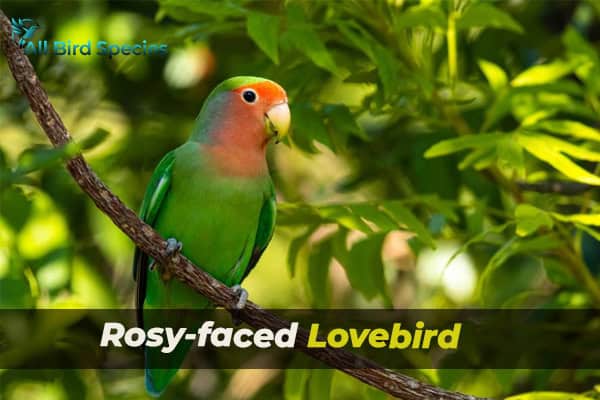
The rosy-faced lovebird is highly social, often found in large flocks. The bird’s bright orange beak is an important part of its social dynamics, used for both feeding and grooming other birds in the flock. The lovebird’s strong, vibrant beak also plays a role in its courtship rituals, where it can often be seen sharing food or feeding its mate.
Rosy-faced Lovebird Attributes:
- Length: 6 inches
- Weight: 1 ounce
- Beak Length: 1 inch
- Habitat: Shrublands and savannas of southwestern Africa
- Diet: Seeds, fruits, and berries
- Conservation Status: Least concern
18. Bearded Vulture (Gypaetus barbatus)
The bearded vulture, known for its distinctive dark facial feathers resembling a beard, has a powerful and colorful beak. The bill is large, curved, and black, with a distinct reddish tint around the edges. This vulture is found in mountainous regions across Europe, Asia, and Africa, where it feeds primarily on bones, which it drops from great heights to break them open.

The bearded vulture’s bill is perfectly adapted for this task, allowing it to crack open bones and access the nutritious marrow inside. The bird’s beak, along with its impressive hunting technique, makes it a unique predator in the avian world. The colorful markings around the beak, especially in young birds, add to their distinctiveness.
Bearded Vulture Attributes:
- Length: 38-45 inches
- Weight: 5-9 pounds
- Beak Length: 3-4 inches
- Habitat: Mountainous regions in Europe, Asia, and Africa
- Diet: Bone marrow, small mammals, and carrion
- Conservation Status: Near Threatened
19. Victoria Crowned Pigeon (Goura victoria)
The Victoria crowned pigeon is a large, majestic bird native to New Guinea. Known for its striking appearance, this pigeon has a colorful, light-blue beak that contrasts beautifully with its deep-blue body and ornate crown of feathers. The pigeon uses its beak to pick seeds, fruits, and small insects from the forest floor. It is a ground-dwelling bird, often seen in the dense rainforests of its native habitat.
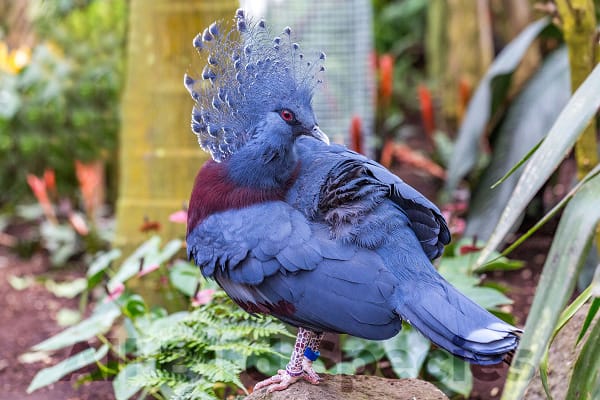
The Victoria crowned pigeon is a shy and elusive species, rarely seen in the wild due to its preference for dense, remote forests. Its beautiful blue beak adds to its overall regal appearance, making it one of the most remarkable pigeon species in the world.
Victoria Crowned Pigeon Attributes:
- Length: 29-36 inches
- Weight: 3.5-7 pounds
- Beak Length: 1 inch
- Habitat: Rainforests of New Guinea
- Diet: Seeds, fruits, and small invertebrates
- Conservation Status: Near Threatened
20. Crested Auklet (Aethia cristatella)
The crested auklet Birds With Colorful Beaks is a small seabird found in the North Pacific. It is famous for its unique bill, which is orange and shaped like a small hook. The bird’s bright orange bill is set against its dark plumage, giving it a striking, yet charming, appearance. The auklet uses its bill to capture small fish and crustaceans, which it finds in the cold waters of the North Pacific.
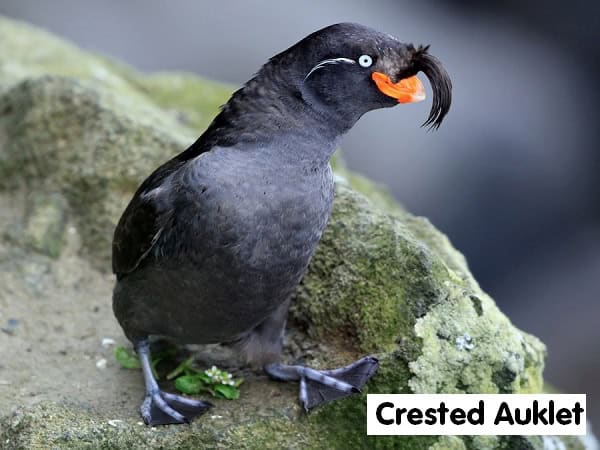
During the breeding season, the crested auklet’s bright orange beak becomes an important feature in courtship displays. Male auklets use their colorful bills to attract females, showing off their physical health and fitness. These birds form large colonies on rocky shorelines, where their vibrant bills can be seen in full display.
Crested Auklet Attributes:
- Length: 10-12 inches
- Weight: 0.6-0.8 pounds
- Beak Length: 1 inch
- Habitat: Coastal waters of the North Pacific
- Diet: Fish, crustaceans, and plankton
- Conservation Status: Least concern
Conclusion
These 20 birds with colorful beaks are just a small sampling of the fascinating avian world. Their bright, distinctive beaks not only serve functional purposes but also add to their allure and beauty. From the massive bill of the toucan to the delicate beak of the kingfisher, each species showcases the incredible diversity of birds across the globe. The stunning colors of their beaks play a role in communication, mating rituals, and feeding habits, proving that these birds are not only visually striking but also ecologically significant.
Frequently Asked Questions
Q1. What are birds with the most colorful beaks?
Birds like toucans, puffins, macaws, and flamingos have some of the most colorful beaks, ranging from bright oranges and reds to multi-hued patterns.
Q2. Why do some birds have colorful beaks?
Colorful beaks often serve as a means of attracting mates, signaling health and vitality. They can also help in species recognition or intimidating rivals.
Q3. What bird has a rainbow-colored beak?
The keel-billed toucan is famous for its rainbow-colored beak, featuring shades of green, orange, blue, and red.
Q4. Are colorful beaks a sign of health in birds?
Yes, in many bird species, the vibrancy of a beak’s color indicates good health, as it reflects proper diet and hormone levels.
Q5. Which tropical birds are known for their colorful beaks?
Tropical birds like toucans, hornbills, and parrots (e.g., macaws) are known for their bright and strikingly colorful beaks.



